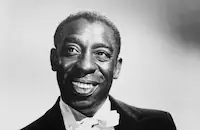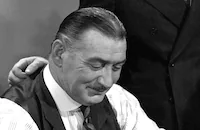The Toy Wife

Brief Synopsis
Cast & Crew
Richard Thorpe
Luise Rainer
Melvyn Douglas
Robert Young
Barbara O'neil
H. B. Warner
Film Details
Technical Specs

Synopsis
In the early 1800's, sixteen-year-old coquette Gilberte Brigard, called "Frou Frou," returns from school in France to her Louisiana plantation. Craving excitement, Frou Frou feigns a toothache so that she can visit the dentist in New Orleans. Although her travelling chaperone, Madame Vallaire, tries to watch over Frou Frou, she sneaks away to attend a ball where she meets Madame Vallaire's wastral son Andre, with whom she is infatuated. Upon their return home, Frou Frou and her more stable older sister Louise attend Georges Sartoris, a family friend who is recovering from a knife wound received while prosecuting a white man accused of killing a young slave. Although Louise is in love with Georges, she encourages him to marry her sister when she learns that he is in love with Frou Frou. Five years later, as Georges and Frou Frou's son Georgie is celebrating his fourth birthday, Georges has become concerned that Frou Frou's youthful playfulness has not decreased during their marriage. Because he fears that their marriage will be destroyed because she is unable to run their household, he asks Louise to stay with them and take charge, telling her that Frou Frou is merely a "toy wife." While Louise runs the household, Frou Frou happily begins rehearsing an amateur play with Andre with whom she become reacquainted after a chance meeting. Soon, however, she begins to realize that Louise has supplanted her position within the household. When even little Georgie seems to prefer Louise to his mother, Frou Frou confronts Louise, who still loves Georges, but has only been trying to save Frou Frou's marriage. When Louise tells her sister why Georges wanted her to come into their home, Frou Frou decides to leave with Andre, who has asked her to elope with him. Six months later, after Madame Vallaire tells Frou Frou's father Victor that the pair has gone to New York, he dies of a heart attack. Because Frou Frou turns her inheritance over to Georgie, she and Andre are soon destitute due to his gambling debts. They then return to New Orleans after which Georges challenges Andre to a duel. Although Andre is known to be the better shot, he is killed by Georges. Frou Frou and her maid "Pick" soon are impoverished and she is weakened by pneumonia. One evening, after Frou Frou offers prayers in a small church, Louise finds her. Georges refuses to see her or allow their son to see her, until Louise makes him realize that Frou Frou only became his toy wife because that was what he really wanted. Georges finally goes to Frou Frou and brings her home where she dies after telling him that Louise loves him and will make him a good wife.

Director

Richard Thorpe
Cast

Luise Rainer

Melvyn Douglas

Robert Young

Barbara O'neil

H. B. Warner
Alma Kruger
Libby Taylor
Theresa Harris

Walter Kingsford
Clinton Rosemond

Clarence Muse
Leonard Penn
Alan Perl
Margaret Irving

Rafaela Ottiano
Beulah Hall Jones
George H. Reed
Madame Sul-te-wan
Hal Le Seur
Tom Rutherford

Douglas Mcphail

Edward Van Sloan
Albert Morin

Edward Keane
D'arcy Corrigan
Natalie Garson
George Regas
Charles Albin
Esther Muir
Priscilla Lawson
Brent Sargent
Marguerite Whitten
Billy Mcclain
George Humbert
Henry Roquemore
Robert Spindola
Barbara Bedford

Ruby Elzy
Myrtle Anderson
Willa Curtis
Gertrude Saunders
Violet Mcdowell
Cora Lang
Irene Allen
Olive Ball
Geneva Williams
Mary Luster
Edna Franklin
Charles Andrews
Ernest Wilson
Henry Thomas
Louise Robinson
Fannie Washington
Crew
Adrian
Zoë Akins
Merian C. Cooper
Cedric Gibbons
Robert A. Golden
Oliver T. Marsh
Harry Mcafee
Douglas Shearer
Gile Steele
Elmo Veron
Edward Ward
Edwin B. Willis

Film Details
Technical Specs

Articles
The Toy Wife
Rainer had taken MGM by storm when a studio talent scout spotted her in one of the three German-language films she made in the early '30s. After a strong studio debut in the sophisticated romantic drama Escapade (1935), she had captured back-to-back Oscars® for The Great Ziegfeld (1936) and The Good Earth (1937), but that's where the trouble started. Rainer had become a star without clearly establishing a star persona. Studio head Louis B. Mayer instructed his writers to come up with more "Luise Rainer vehicles," but nobody had any idea what that meant. Moreover, critics, who had applauded her first films, suddenly didn't care for her as much, partly because of the hastily assembled vehicles MGM assigned her and partly out of anger that her second Oscar® had come at the expense of Greta Garbo's justly famed performance in Camille (1937). Just to make matters worse, the off-screen Rainer had little patience with Hollywood or film moguls. She insisted on walking around town without makeup and wearing slacks. She tried to demand a new contract giving her a higher salary. And she often made Mayer deal with her husband, playwright Clifford Odets, whom she enlisted in her fight for better material and whose liberal politics made him politically suspicious in conservative Hollywood.
It was in this atmosphere of tension and dashed hopes that MGM cast her in The Toy Wife. Perhaps it was the role's pedigree that made it seem suitable for the newly minted diva. Although the original French play Frou-frou was not credited on screen (though the original title remained the leading lady's nickname, and the studio briefly considered calling the picture Mlle. Froufrou), the film was adapted from a 19th century French play that had supplied Sarah Bernhardt with one of her most popular stage vehicles. Just as likely, however, was the possibility that they wanted to cash in on the publicity surrounding Margaret Mitchell's Gone with the Wind and David O. Selznick's impending film version. Warner's had jumped on the bandwagon by casting Bette Davis in Jezebel (1938), so MGM had to have its own fiery Southern girl. Of course, this Southern belle had a German accent, so the story was re-set in pre-war New Orleans and Rainer's character, Gilberte, was only recently returned from an extended stay in Paris.
The production that resulted was a curious mix of MGM elegance and cost cutting. Since Rainer was now considered a star, the studio didn't want to put one of its highly paid leading men into what was clearly a vehicle for her, so they borrowed Melvyn Douglas from Universal to play Rainer's husband and cast studio stand-by Robert Young as her rejected suitor. Many of the sets were recycled from other productions, though that was pretty much standard practice in Hollywood. At least they assigned a top writer, Zoe Akins, to the screenplay. Akins was a popular playwright who had won the Pulitzer Prize in 1935 for The Old Maid. She had most recently written Camille, and even borrowed the film's climax, with a tubercular Rainer dying in Douglas' arms.
The critics, however, weren't having any of it. They dismissed The Toy Wife as a tearjerker, complaining that the plot lurched from one contrivance to another trying to generate the maximum emotional response from the audience. Moreover, Rainer seemed to have worn out her welcome. Where once they had found her enchanting, they now called her tedious. The New York Times reviewer complained, "...Miss Rainer's 'toy wife' is wound too tightly for anybody's comfort -- even in a divan seat. And with all due respect, we do think Miss Rainer should be informed that there is such a thing as being too feminine." Neither she nor MGM were happy with the results. She would make only one more film for the studio before moving back to New York to be with Odets, a move that prompted Mayer to cancel her contract.
Only one performer came out of The Toy Wife with anything positive. Barbara O'Neil, cast as Rainer's sister, had parlayed her beauty and a natural sense of style into a burgeoning stage career (she started out with Henry Fonda, James Stewart and Margaret Sullavan in summer stock) and was only recently arrived in Hollywood, where she had debuted as Barbara Stanwyck's romantic rival in Stella Dallas (1937). In her third film, she was so impressive at holding her own against Rainer's star performance that she caught Selznick's attention and landed the role of mother to the screen's ultimate Southern belle, Scarlett O'Hara in Gone with the Wind (1939).
Producer: Merian C. Cooper
Director: Richard Thorpe
Screenplay: Zoe Akins
Adapted (uncredited) from the play Frou-frou by Ludovic Halevy, Henri Meilhac and Augustin Daly Cinematography: Oliver T. Marsh
Art Direction: Cedric Gibbons
Music: Edward Ward
Principal Cast: Luise Rainer (Gilberte "Frou Frou" Brigard), Melvyn Douglas (George Sartoris), Robert Young (Andre Vallaire), Barbara O'Neil (Louise Brigard), H.B. Warner (Victor Brigard), Alma Kruger (Madame Vallaire), Clarence Muse (Brutus), Hal Le Sueur (First Brother), Douglas McPhail (Leon, the Second Brother), Esther Muir (Blonde Woman), Rafaela Ottiano (Felicianne), Madame Sul-Te-Wan (Eve), Edward Van Sloan (Older Man). BW-96m.
by Frank Miller

The Toy Wife
Quotes
Trivia
The play "Frou-frou" by Henri Meilhac and Ludovic Halevy opened in Paris, France on 30 October 1869. Its English adaptation, "Frou Frou," by Augustin Daly, opened in New York on 15 February 1870.
Notes
The film's pre-production title was Mlle. Froufrou. A written prologue following the opening credits reads: "Gone is the flag of France from Louisiana, but until the Civil War the life of its French residents in New Orleans and on the great plantations was under the old regime of France." Although Zoë Akin's screenplay was based on the French and American versions of the play Froufrou, no underlying dramatic or literary work is credited on screen. Screen Achievements Bulletin notes that the screenplay was "not original" but does not mention the source which "could not be shown," according to a hand-written notation on the Screen Achievements Bulletin form. Richard Thorpe had to be replaced as the director of M-G-M's The Shopworn Angel (see AFI Catalog of Feature Films, 1931-40; F3.4038) because of a scheduling conflict with this film. According to a Hollywood Reporter news item, portions of the film were shot on location at Sherwood Forest, California. Other versions of the same story include a 1914 Thanhouser film entitled Frou Frou, directed by Lloyd Lonergan and starring Maude Fealy, and a 1917 Peerless production called A Hungry Heart directed by Emile Chautard and starring Alice Brady (see AFI Catalog of Feature Films, 1911-20; F1.1493 and F1.2101), a 1918 Italian film and a 1923 French film, both called Frou-Frou.














